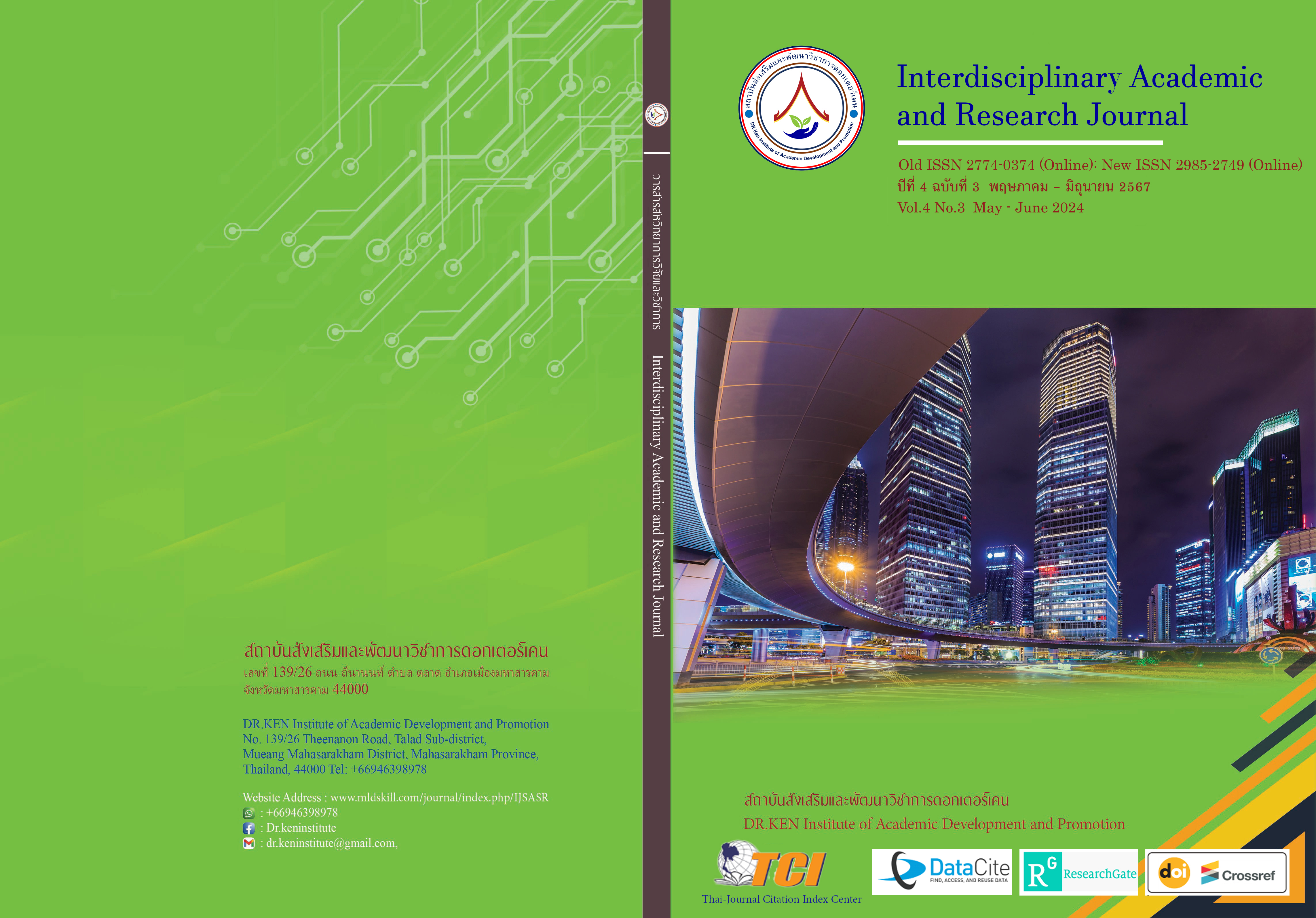Herb Use Behavior for Long COVID Care among People in Ang Sila Sub-district, Mueang Chonburi District, Chon Buri Province
DOI:
https://doi.org/10.60027/iarj.2024.276316Keywords:
Herbs; , Herb Use Behavior; , Problems; , Long COVIDAbstract
Background and Aims: Herbs are regarded as a viable option for disease prevention and treatment, and they are widely used in modern medicine and dietary supplements. The advantage of employing herbs as a medicine is that children have been taught this skill by their ancestors. The objectives of this study were to investigate the problems encountered by people in the Ang Sila Sub-district who used herbs in managing Long COVID symptoms and herb use behavior for Long COVID care in 20 people.
Methodology: In this study, the qualitative research methodology was used. The data was collected using structured interviews, unstructured interviews, and observation forms developed by the researchers. The data analysis was performed using descriptive statistics.
Results: According to the study of herb use behavior among the sample, it was found that the sample had correct basic knowledge about the use of herbs in alleviating Long COVID symptoms. They gained this knowledge from researching and searching for information through online media. This made herbs play a role in primary health care for the people of Ang Sila Sub-district, especially during the COVID-19 pandemic. This was because herbs are widely available and inexpensive. As for the situation and problems of the use of herbs, it was found that online media often provides false information, frequently exaggerating how beneficial they are, which encourages people to use herbs regularly.
Conclusion: The study of herb use behavior for Long COVID care showed that the sample had basic knowledge about using herbs. However, they had incorrect herb use behavior and had incomplete information and knowledge.
References
กรมควบคุมโรค กระทรวงสาธารณสุข. (2563). โรคติดเชื้อโคโรนาไวรัส-19(ออนไลน์). Retrieved from: https://ddc.moph.go.th/viralpneumonia/index.php.
กรมควบคุมโรค กระทรวงสาธารณสุข. (2564). รายงานสถานการณ์โรคติดเชื้อไวรัสโคโรน่า 2019 โดยศูนย์ปฏิบัติการภาวะฉุกเฉิน กรมควบคุมโรค(ออนไลน์). Retrieved on 10 August 2022 from https://ddc.moph.go.th/viralpneumonia/
กรมควบคุมโรค. (2565). โรคติดเชื้อไวรัสโคโรนา 2019. Retrieved on 10 August 2022 from https://ddc.moph.go.th/viralpneumonia/
ชนิดา มัททวางกูร, ขวัญเรือน ก๋าวิตู, สุธิดา ดีหนูและสิริณัฐ สินวรรณกุล. (2562). ปัจจัยที่มีความสัมพันธ์กับพฤติกรรมการใช้สมุนไพรของประชาชนในเขตภาษีเจริญ. วารสารพยาบาลศาสตร์ มหาวิทยาลัยสยาม, 20(39), 99 – 109.
ซารีฟะห์ เจ๊ะแว. (2560). ปัจจัยคัดสรรตามแบบแผนความเชื่อด้านสุขภาพที่ส่งผลต่อพฤติกรรมการใช้หมวกนิรภัย ในการป้องกันอุบัติเหตุของนักศึกษาสถาบันการพลศึกษา วิทยาเขตยะลา. มหาวิทยาลัยสงขลานครินทร์ วิทยาเขตปัตตานี
มหาวิทยาลัยมหิดล. (2563). ยาสมุนไพรปลอดภัยเมื่อใช้ถูกหลัก. Retrieved on 10 August 2022 from: https://www.gj.mahidol.ac.th/main/ttm/herb-right/
ยุพดี ตรีชาลา, สุมัทนา กลางคาร และจารุวรรณ วิโรจน์ (2565). การศึกษาสมรรถนะการป้องกันและควบคุมโรคติดเชื้อไวรัสโคโรนา 2019 (Covid-19) ของอาสาสมัครสาธารณสุขประจำหมู่บ้าน (อสม.). วารสารสำนักงานป้องกันควบคุมโรคที่ 10 จังหวัดอุบลราชธานี, 20 (2), 46-47.
โรงพยาบาลวิชัยเวช. (2564). รู้จักลองโควิด “Long Covid” อาการหลงเหลือหลังติดเชื้อโควิด-19); รู้จักลองโควิด “Long Covid” อาการหลงเหลือหลังติดเชื้อโควิด-19. Retrieved on 10 August 2022 from: https://vichaivej-nongkhaem.com/health-info/รู้จักลองโควิด)
วาสนา สิทธิกัน. (2560). ปัจจัยที่มีผลต่อพฤติกรรมส่งเสริมสุขภาพของผู้สูงอายุ ในเขตเทศบาลตำบลบ้านโฮ่ง อำเภอบ้านโฮ่ง จังหวัดลำพูน. บัณฑิตวิทยาลัย: มหาวิทยาลัยราชภัฏเชียงใหม่
องค์การบริหารส่วนจังหวัดชลบุรี. (2565). รายงานการแพร่ระบาดของเชื้อไวรัสโคโรน่า (2019) จังหวัดชลบุรี. Retrieved on 10 August 2022 from: https://www.chon.go.th/cpao/news/3131/topic
Becker, W., Berg, L., & Becker, B.E. (1984). The long-term evaluation of periodontal treatment and maintenance in 95 patients. Int J Periodontics Restorative Dent. 4(2), 54-71. PMID: 6589217.
Chantachon, S. (2020). Culture Qualitative Research (Fieldwork). Faculty of Humanities and Social Science Rajabhat Maha Sarakham University.
Dong, E., Du, H., & Gardner, L. (2020). An interactive web-based dashboard to track COVID-19 in real-time. Lancet Infect Dis. 20(5),533-534. doi: 10.1016/S1473-3099(20)30120-1.
Elfiky, A. A. (2020). Anti-HCV, nucleotide inhibitors, repurposing against COVID-19. Life Sciences, 248, 117477.
Hu, K., Guan, W.-J., Bi, Y., Zhang, W., Li, L., Zhang, B., & Liang, J. (2021). Efficacy and safety of Lianhuaqingwen capsules, a repurposed Chinese herb, in patients with coronavirus disease 2019: A multicenter, prospective, randomized controlled trial. Phytomedicine, 85, 153242.
Kurokawa, M., Wadhwani, A., Kai, H., Hidaka, M., Yoshida, H., Sugita, C., & Kawabata, S. (2015). Antiviral traditional medicines against herpes simplex virus (HSV-1), poliovirus, and measles virus. Evidence-Based Complementary and Alternative Medicine, 2015, 1-10.
Nguyen, L.H., Drew, D.A., Graham, M.S., Joshi, A.D., Guo, C.-G., Ma, W., ... & Chan, A.T. (2021). Risk of COVID-19 among frontline healthcare workers and the general community: A prospective cohort study. The Lancet Public Health, 6(1), e13-e23.
Sinwat, S., Sirisa-Ard, P., & Nithikathkul, C. (2022). Use of the Geographic Information System of Medicinal Plants used in Malaria Treatment by Folk Healers in Chanthaburi Province., Neuro Quantology, 20(6), 4346-4356.
Wang, S., Chen, L., Lin, Y., & Lin, X. (2021). Clinical observation on Qing-Fei-Pai-Du-Tang combined with conventional therapy in the treatment of common COVID-19. World Chinese Medicine, 16(6), 875-878.
Downloads
Published
How to Cite
Issue
Section
License
Copyright (c) 2024 Interdisciplinary Academic and Research Journal

This work is licensed under a Creative Commons Attribution-NonCommercial-NoDerivatives 4.0 International License.
Copyright on any article in the Interdisciplinary Academic and Research Journal is retained by the author(s) under the under the Creative Commons Attribution-NonCommercial-NoDerivatives 4.0 International License. Permission to use text, content, images, etc. of publication. Any user to read, download, copy, distribute, print, search, or link to the full texts of articles, crawl them for indexing, pass them as data to software, or use them for any other lawful purpose. But do not use it for commercial use or with the intent to benefit any business.
















.png)


